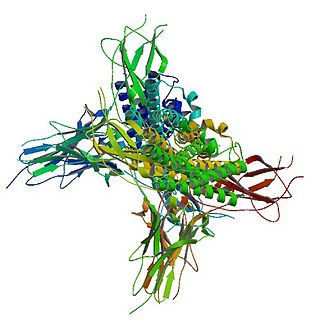
Pain is a distressing feeling often caused by intense or damaging stimuli. The International Association for the Study of Pain defines pain as "an unpleasant sensory and emotional experience associated with, or resembling that associated with, actual or potential tissue damage." In medical diagnosis, pain is regarded as a symptom of an underlying condition.
Chronic pain is classified as pain that lasts longer than three to six months. In medicine, the distinction between acute and chronic pain is sometimes determined by the amount of time since onset. Two commonly used markers are pain that continues at 3 months and 6 months since onset, but some theorists and researchers have placed the transition from acute to chronic pain at 12 months. Others apply the term acute to pain that lasts less than 30 days, chronic to pain of more than six months duration, and subacute to pain that lasts from one to six months. A popular alternative definition of chronic pain, involving no fixed duration, is "pain that extends beyond the expected period of healing".

A phantom limb is the sensation that an amputated or missing limb is still attached. Approximately 80 to 100% of individuals with an amputation experience sensations in their amputated limb. However, only a small percentage will experience painful phantom limb sensation. These sensations are relatively common in amputees and usually resolve within two to three years without treatment. Research continues to explore the underlying mechanisms of phantom limb pain (PLP) and effective treatment options.

Auriculotherapy is a form of alternative medicine based on the idea that the ear is a micro system, which reflects the entire body, represented on the auricle, the outer portion of the ear. Conditions affecting the physical, mental or emotional health of the patient are assumed to be treatable by stimulation of the surface of the ear exclusively. Similar mappings are used by several modalities, including the practices of reflexology and iridology. These mappings are not based on or supported by any medical or scientific evidence, and are therefore considered to be pseudoscience.

Ronald Melzack was a Canadian psychologist and professor of psychology at McGill University. In 1965, he and Patrick David Wall revolutionized pain research by introducing the gate control theory of pain. In 1968, Melzack published an extension of the gate control theory, in which he asserted that pain is subjective and multidimensional because several parts of the brain contribute to it at the same time. During the mid-1970s, he developed the McGill Pain Questionnaire and became a founding member of the International Association for the Study of Pain. He also became the founding editor of Wall & Melzack's Textbook of Pain

Filgrastim, sold under the brand name Neupogen among others, is a medication used to treat low neutrophil count. Low neutrophil counts may occur with HIV/AIDS, following chemotherapy or radiation poisoning, or be of an unknown cause. It may also be used to increase white blood cells for gathering during leukapheresis. It is given either by injection into a vein or under the skin.

Carisoprodol, sold under the brand name Soma among others, is a medication used for musculoskeletal pain. Use is only approved for up to three weeks. Effects generally begin within half an hour and last for up to six hours. It is taken orally.

Piroxicam is a nonsteroidal anti-inflammatory drug (NSAID) of the oxicam class used to relieve the symptoms of painful inflammatory conditions like arthritis. Piroxicam works by preventing the production of endogenous prostaglandins which are involved in the mediation of pain, stiffness, tenderness and swelling. The medicine is available as capsules, tablets and as a prescription-free gel 0.5%. It is also available in a betadex formulation, which allows a more rapid absorption of piroxicam from the digestive tract. Piroxicam is one of the few NSAIDs that can be given parenteral routes.
Neuralgia is pain in the distribution of a nerve or nerves, as in intercostal neuralgia, trigeminal neuralgia, and glossopharyngeal neuralgia.
A pain scale measures a patient's pain intensity or other features. Pain scales are a common communication tool in medical contexts, and are used in a variety of medical settings. Pain scales are a necessity to assist with better assessment of pain and patient screening. Pain measurements help determine the severity, type, and duration of the pain, and are used to make an accurate diagnosis, determine a treatment plan, and evaluate the effectiveness of treatment. Accurately measuring pain is a necessity in medical settings, especially if the pain measurement is going to be used as a screening tool, either for potential diseases or medical problems, or as a type of triage to determine urgency of one patient over another. Pain scales are based on trust, cartoons (behavioral), or imaginary data, and are available for neonates, infants, children, adolescents, adults, seniors, and persons whose communication is impaired. Pain assessments are often regarded as "the 5th Vital Sign".

The gate control theory of pain asserts that non-painful input closes the nerve "gates" to painful input, which prevents pain sensation from traveling to the central nervous system.
A patient-reported outcome (PRO) is a health outcome directly reported by the patient who experienced it. It stands in contrast to an outcome reported by someone else, such as a physician-reported outcome, a nurse-reported outcome, and so on. PRO methods, such as questionnaires, are used in clinical trials or other clinical settings, to help better understand a treatment's efficacy or effectiveness. The use of digitized PROs, or electronic patient-reported outcomes (ePROs), is on the rise in today's health research setting.

Patrick David "Pat" Wall was a British neuroscientist described as 'the world's leading expert on pain' and best known for the gate control theory of pain.

Prucalopride, brand names Resolor and Motegrity among others, is a drug acting as a selective, high affinity 5-HT4 receptor agonist which targets the impaired motility associated with chronic constipation, thus normalizing bowel movements. Prucalopride was approved for medical use in the European Union in 2009, in Canada in 2011, in Israel in 2014, and in the United States in December 2018. The drug has also been tested for the treatment of chronic intestinal pseudo-obstruction.
An electronic patient-reported outcome (ePRO) is a patient-reported outcome that is collected by electronic methods. ePRO methods are most commonly used in clinical trials, but they are also used elsewhere in health care. As a function of the regulatory process, a majority of ePRO questionnaires undergo the linguistic validation process. When the data is captured for a clinical trial, the data is considered a form of Electronic Source Data
Kenneth Lyman Casey is professor emeritus of neurology and professor emeritus of molecular and integrative physiology at the University of Michigan, and consultant in neurology at the Ann Arbor Veteran's Affairs Medical Center.
Wall & Melzack's Textbook of Pain is a medical textbook published by Elsevier. It is named after Patrick David Wall and Ronald Melzack, who introduced the gate control theory into pain research in the 1960s. First released in 1984, the book has been described as "the most comprehensive scientific reference text in the field of pain medicine".

Funapide (INN) is a novel analgesic under development by Xenon Pharmaceuticals for the treatment of a variety of chronic pain conditions, including osteoarthritis, neuropathic pain, postherpetic neuralgia, and erythromelalgia, as well as dental pain. It acts as a small-molecule Nav1.7 and Nav1.8 voltage-gated sodium channel blocker. Funapide is being evaluated in humans in both oral and topical formulations, and as of July 2014, has reached phase IIb clinical trials.
The neuromatrix theory of pain states that the perception of painful stimuli does not result from the brain's passive registration of tissue trauma, but from its active generation of subjective experiences through a network of neurons known as the neuromatrix. The theory was proposed by Ronald Melzack in 1990.

Joel D. Katz is a Canadian psychologist and researcher. He is a Distinguished Research Professor and Canada Research Chair in Health Psychology at York University. He also serves as the research director of the pain research unit in the Department of Anesthesia and pain management at the Toronto General Hospital in addition to serving as a professor in the Department of Anesthesia at the University of Toronto.











